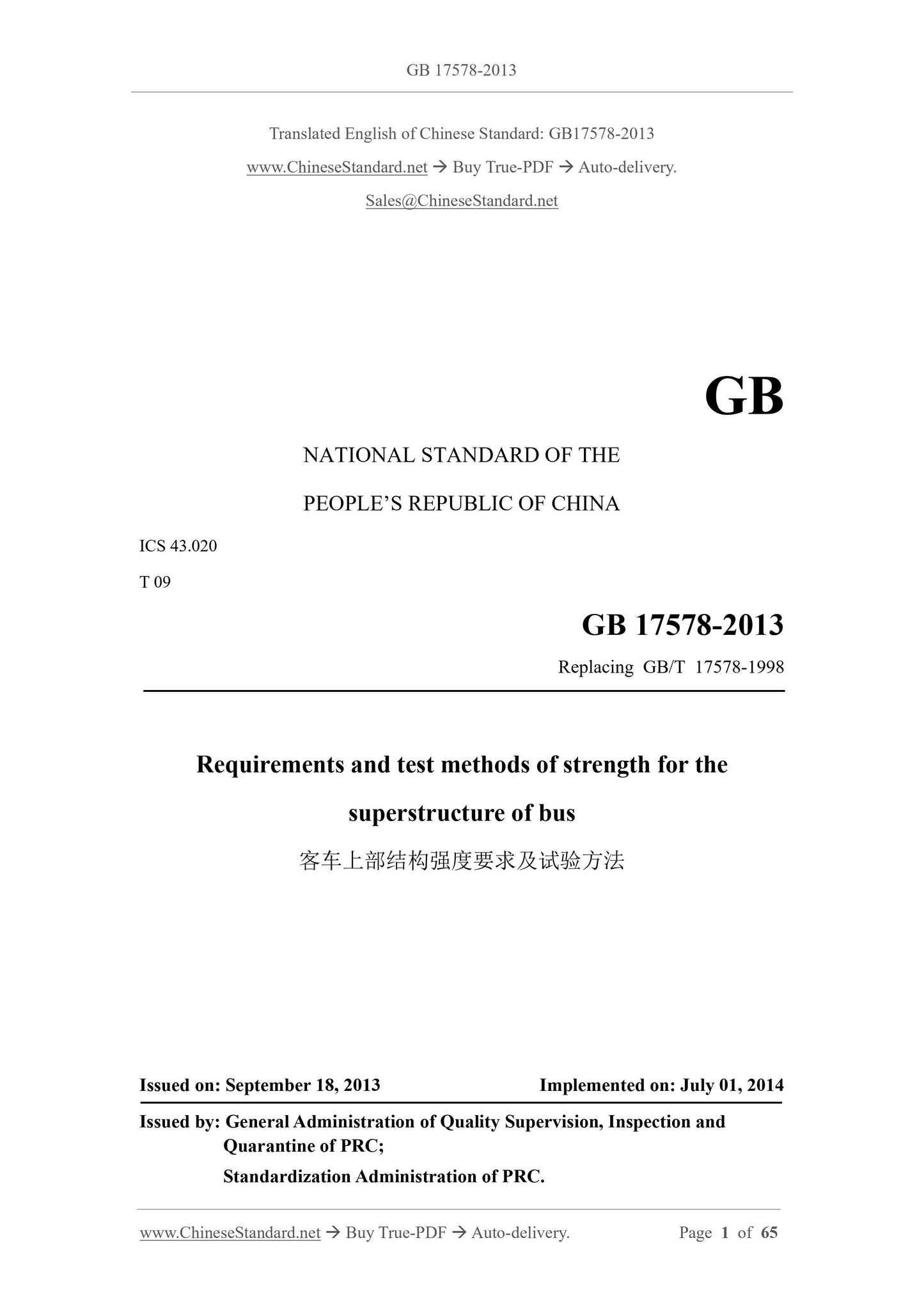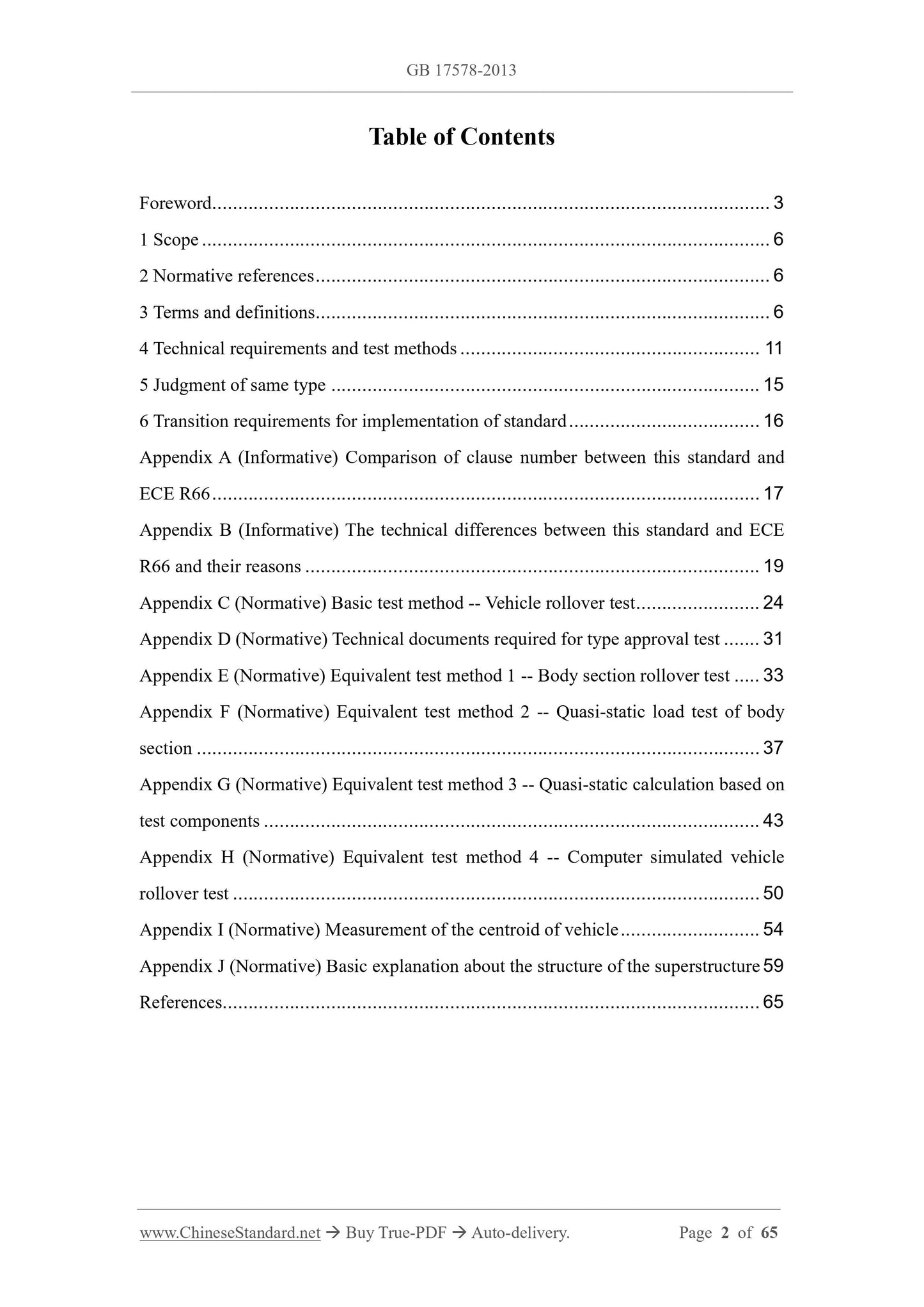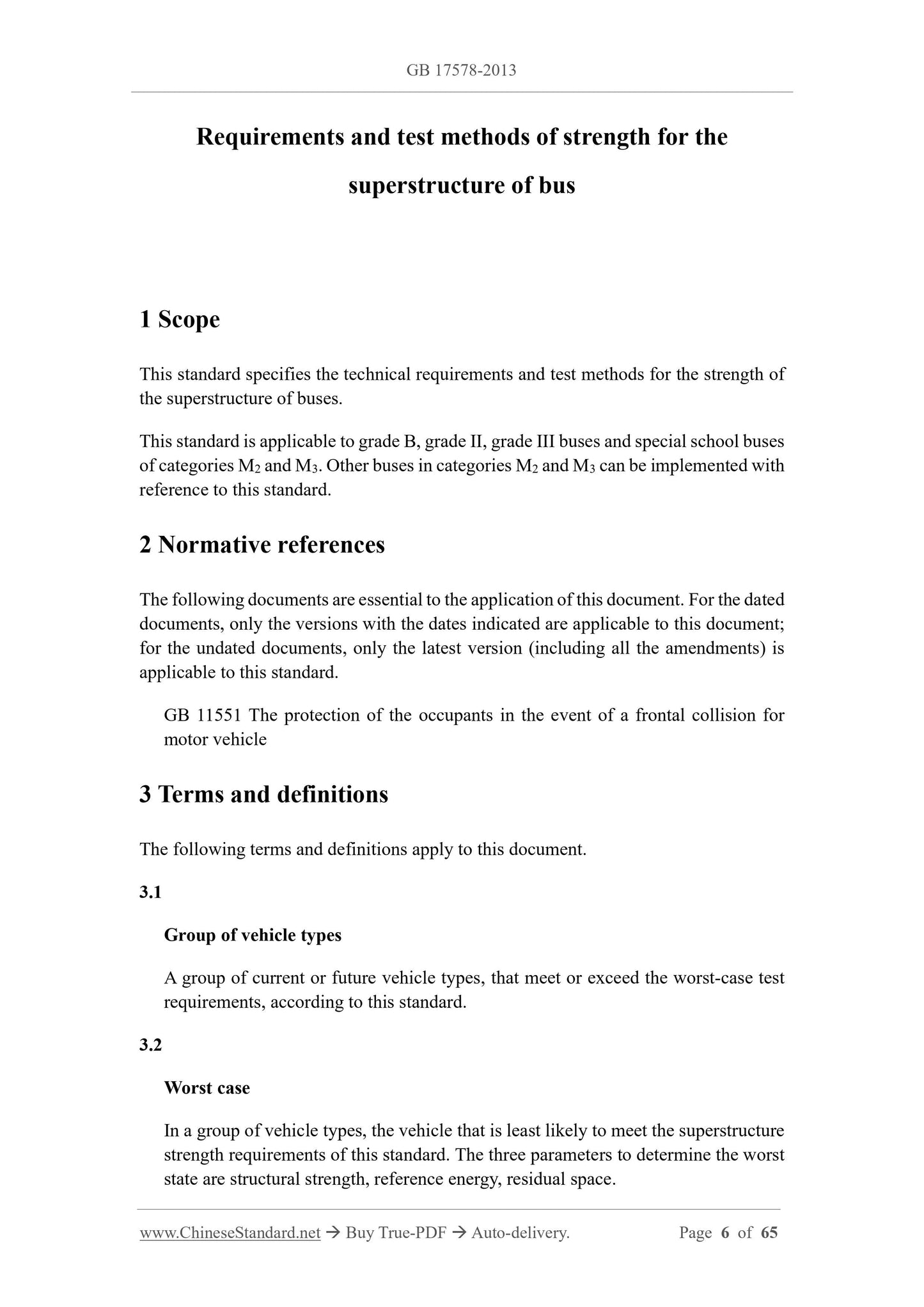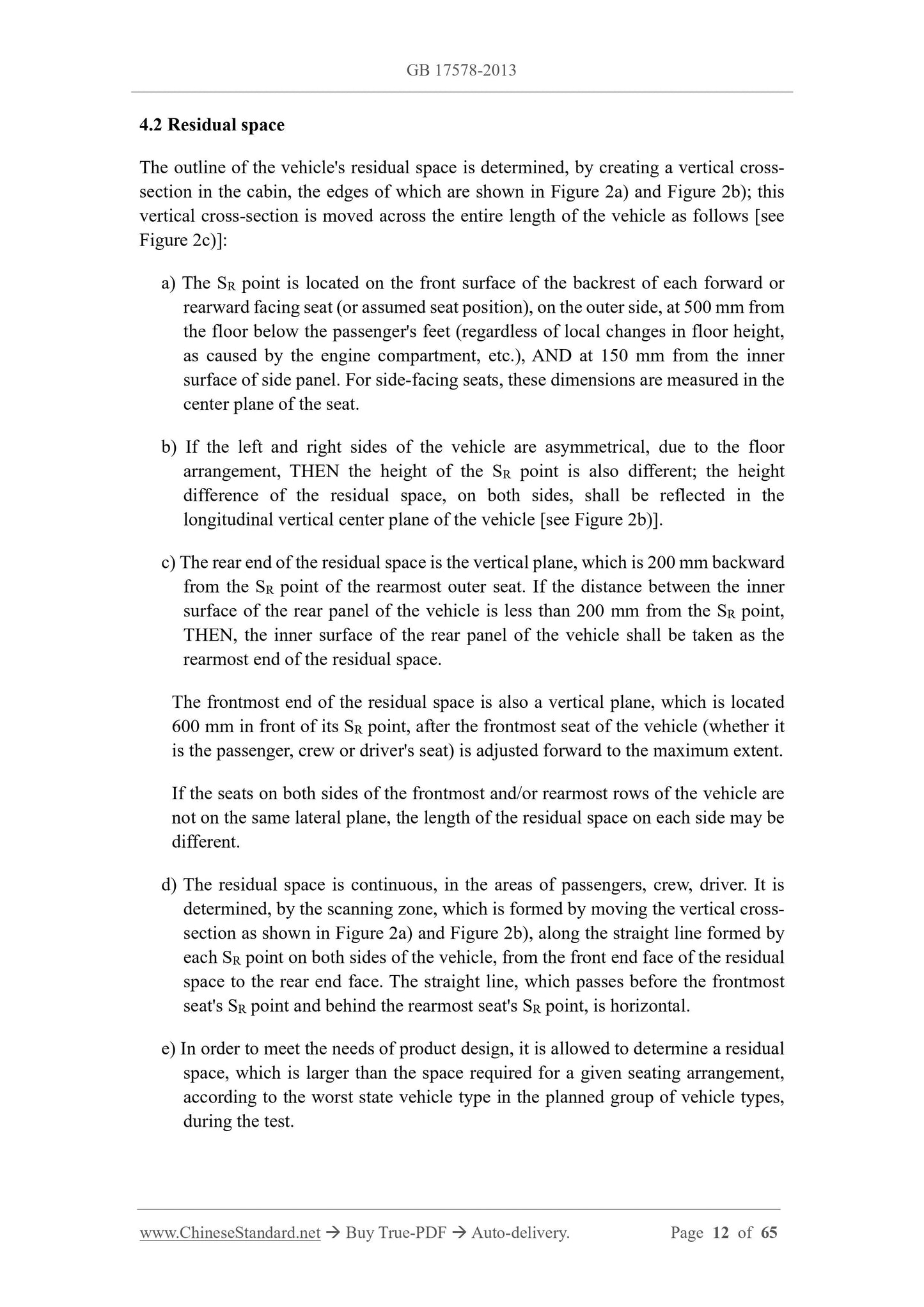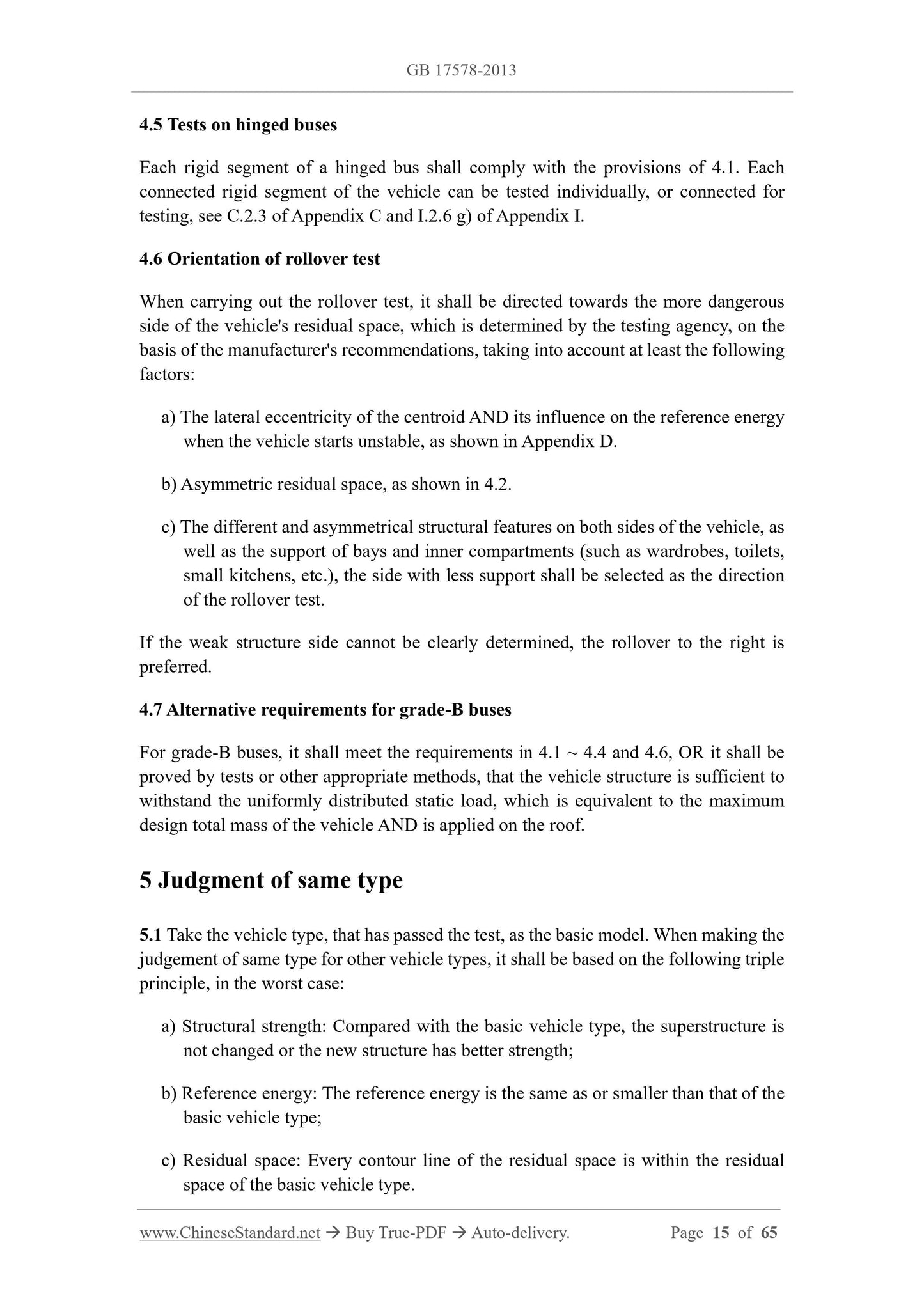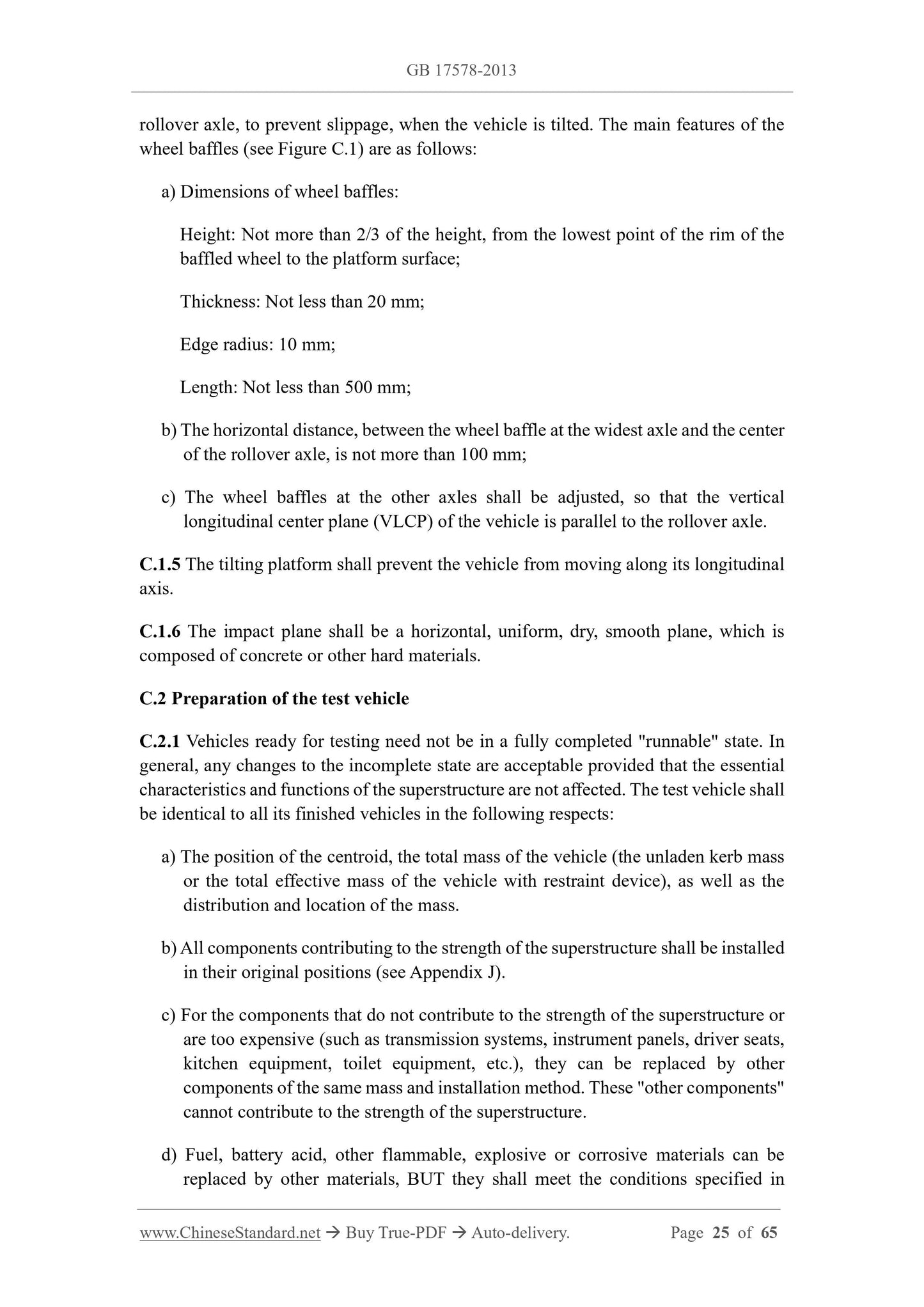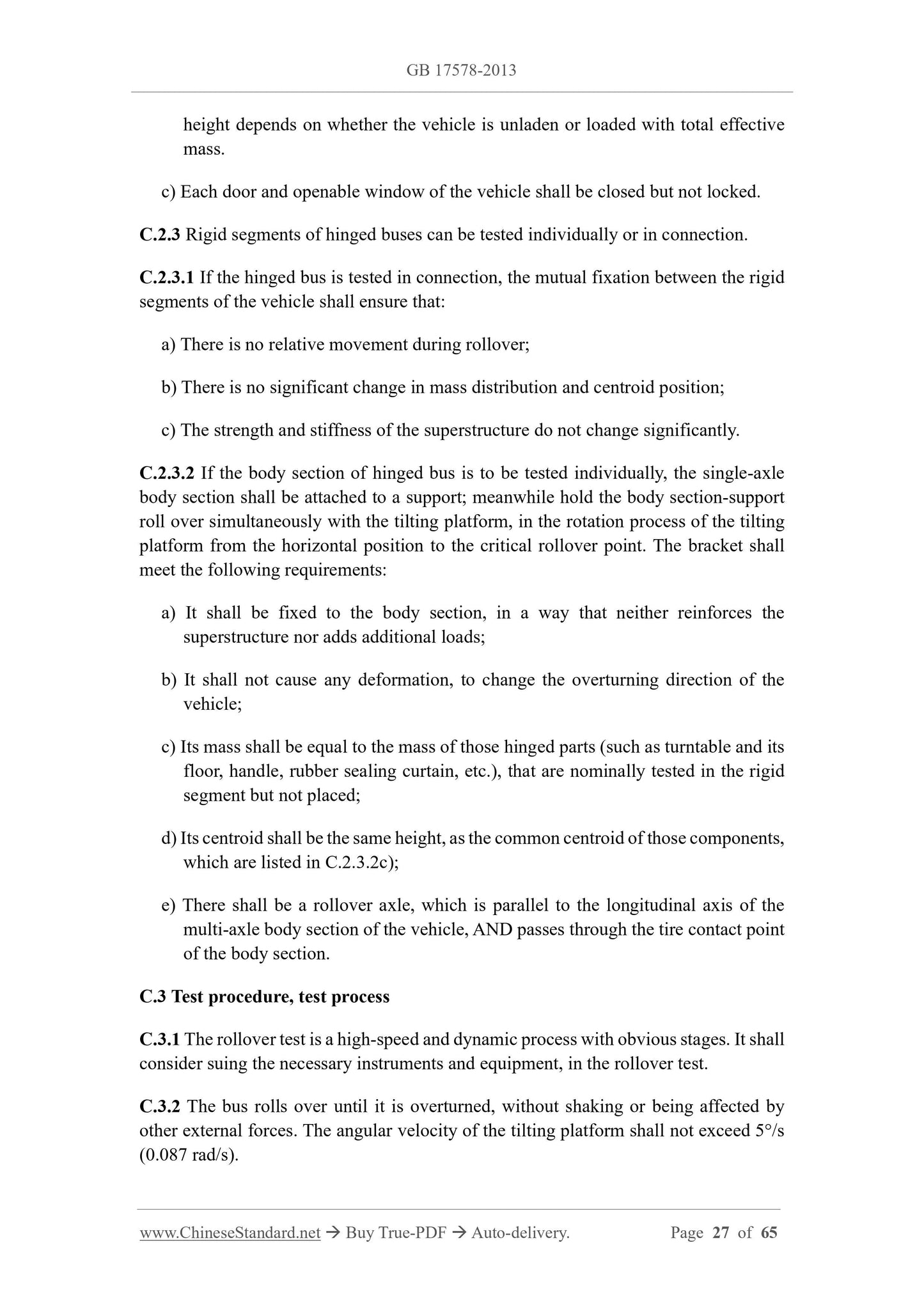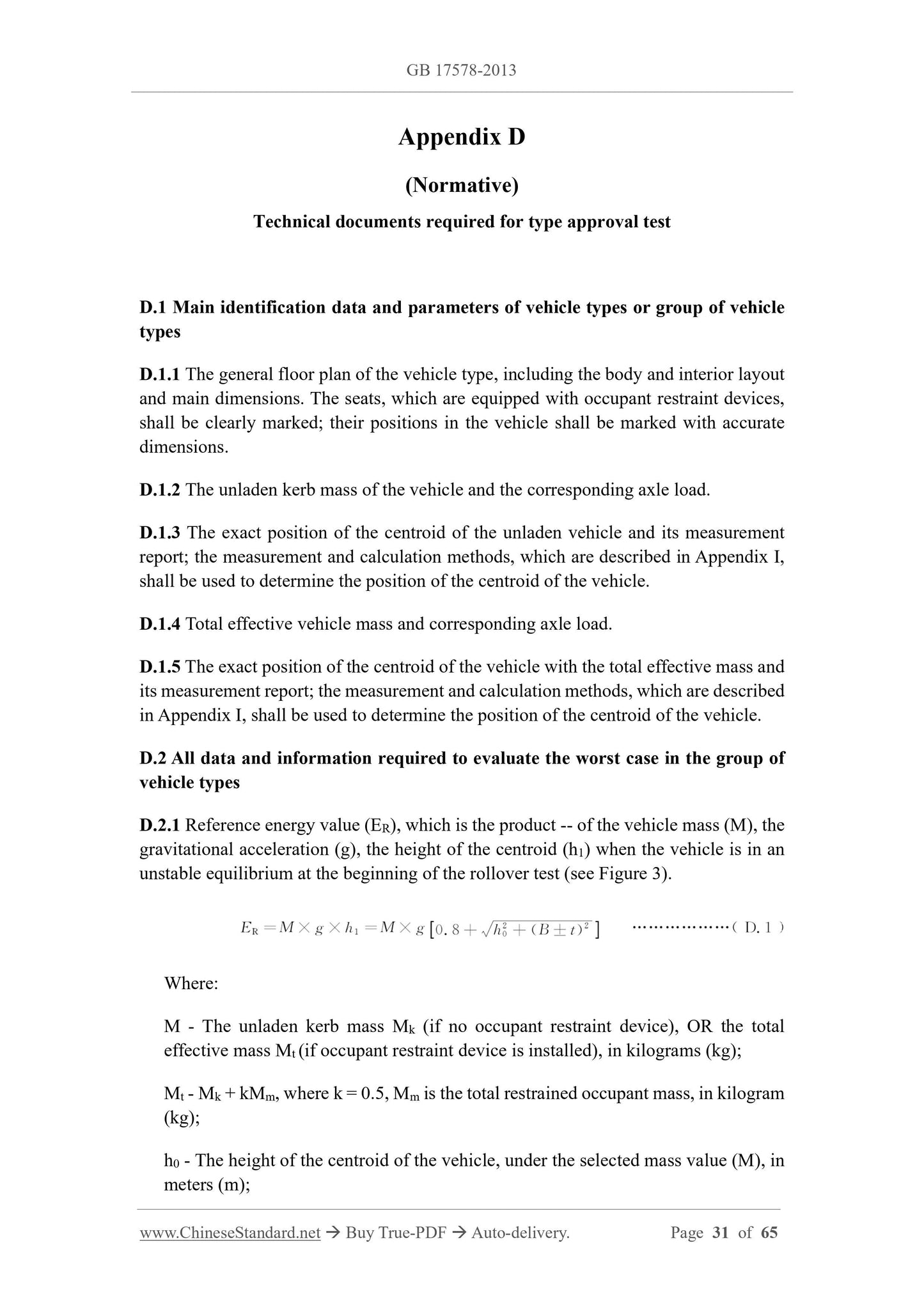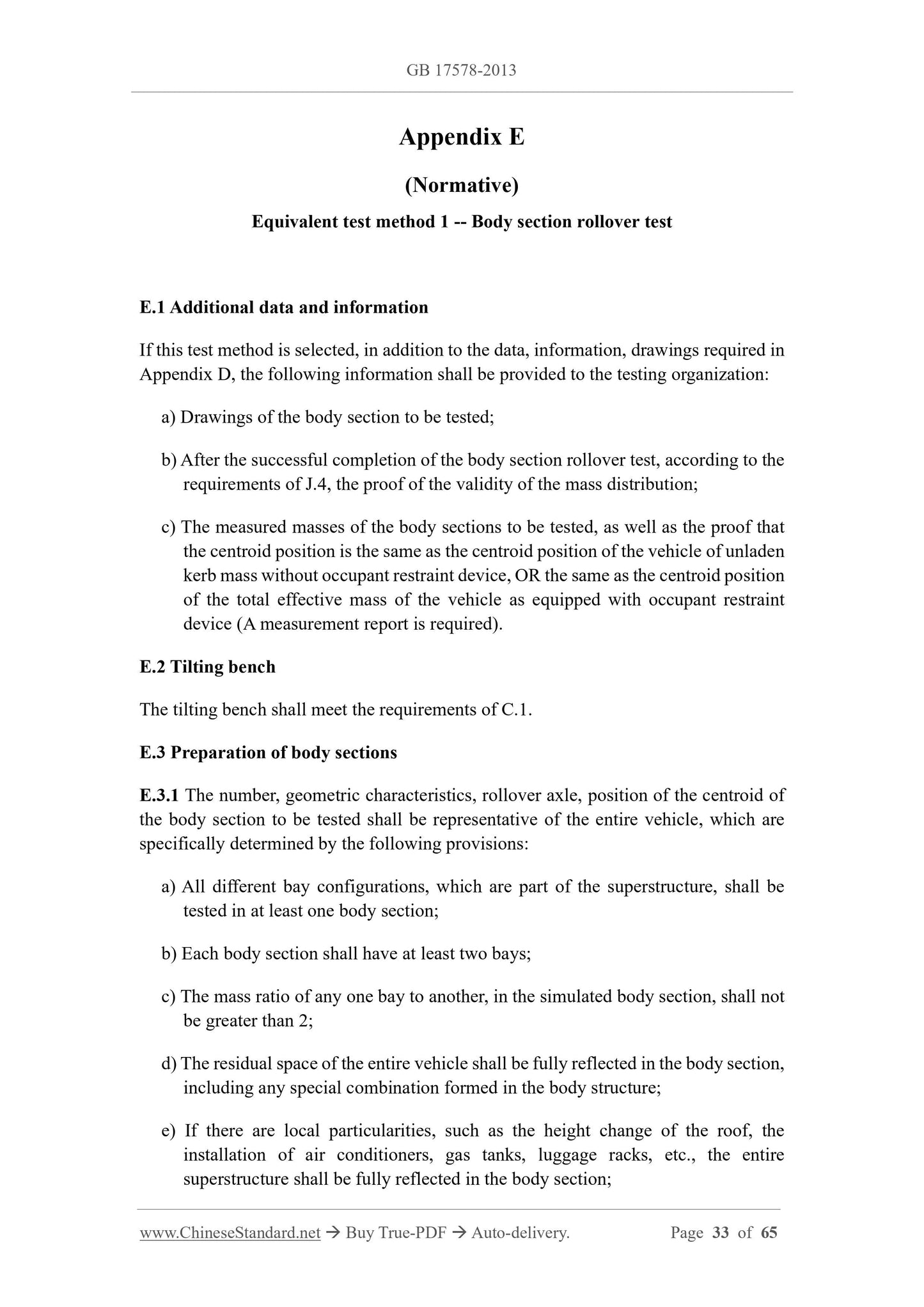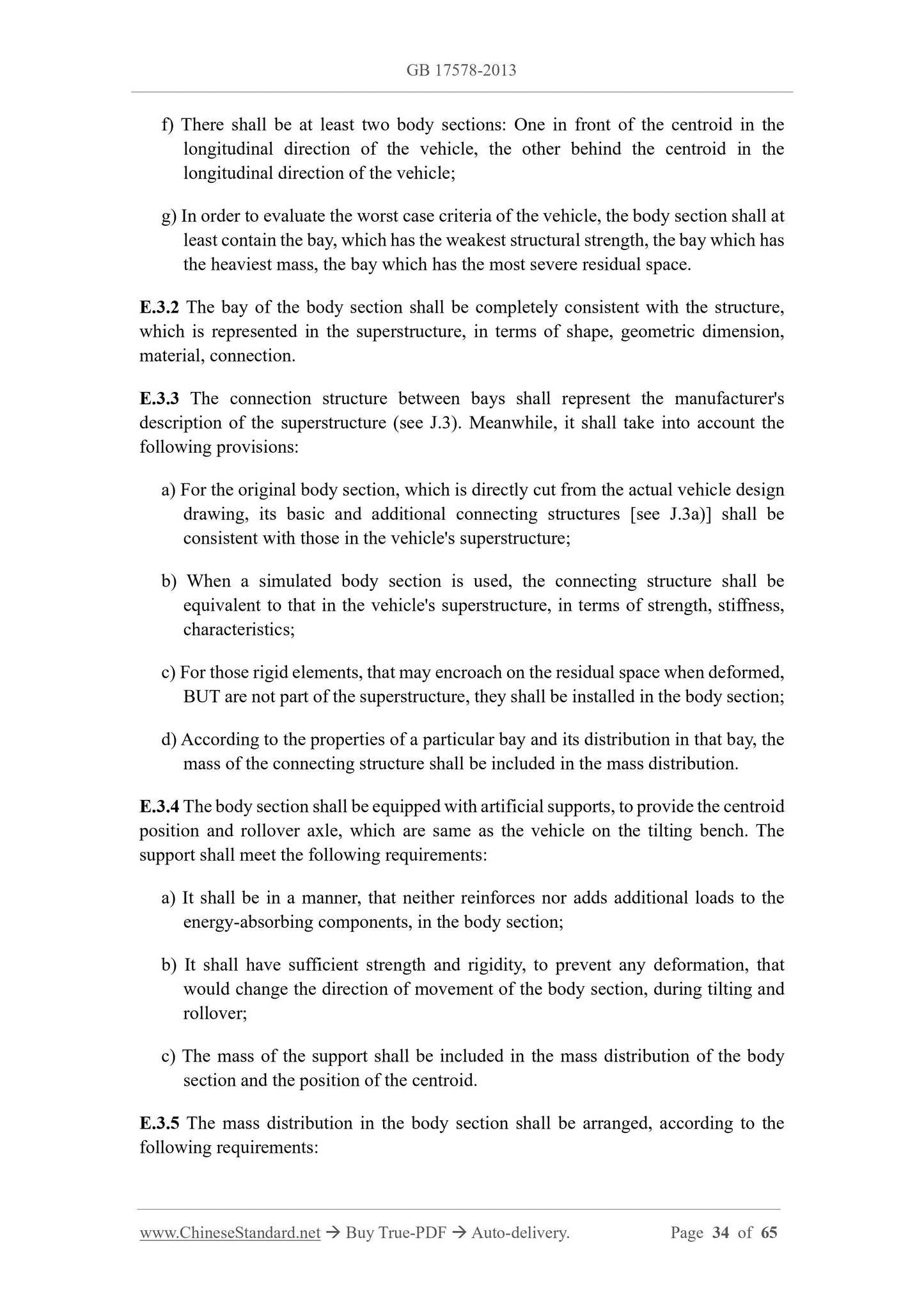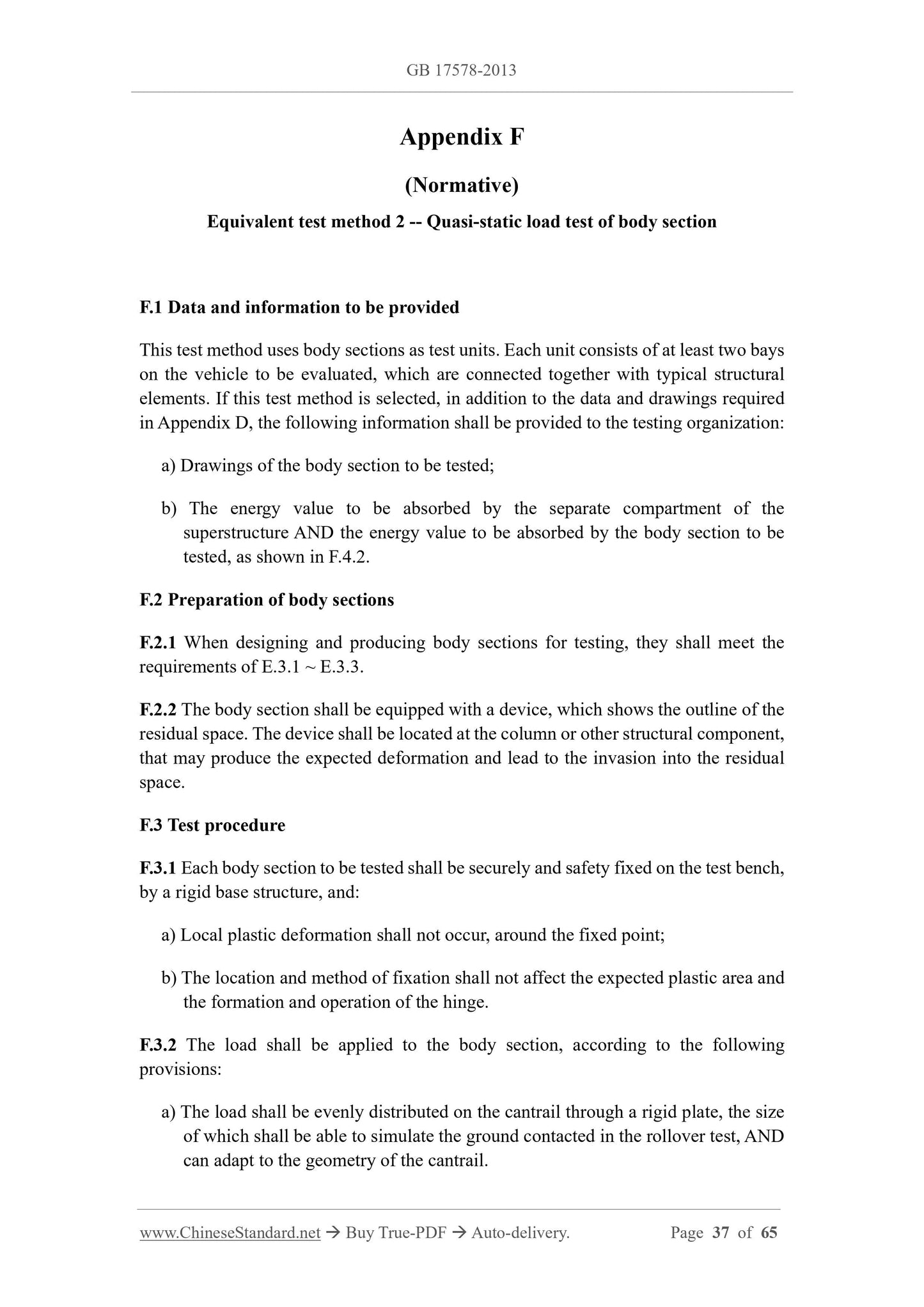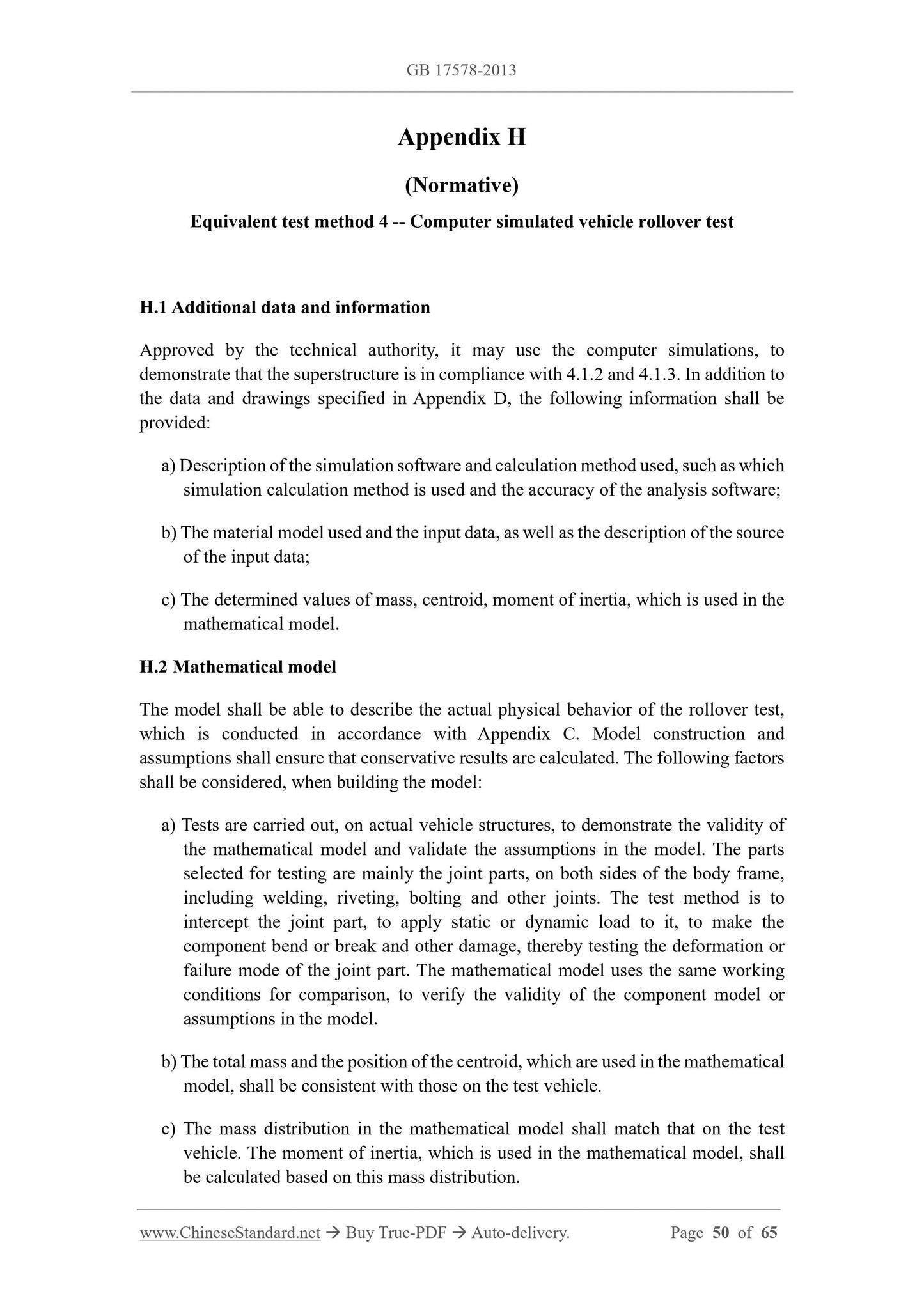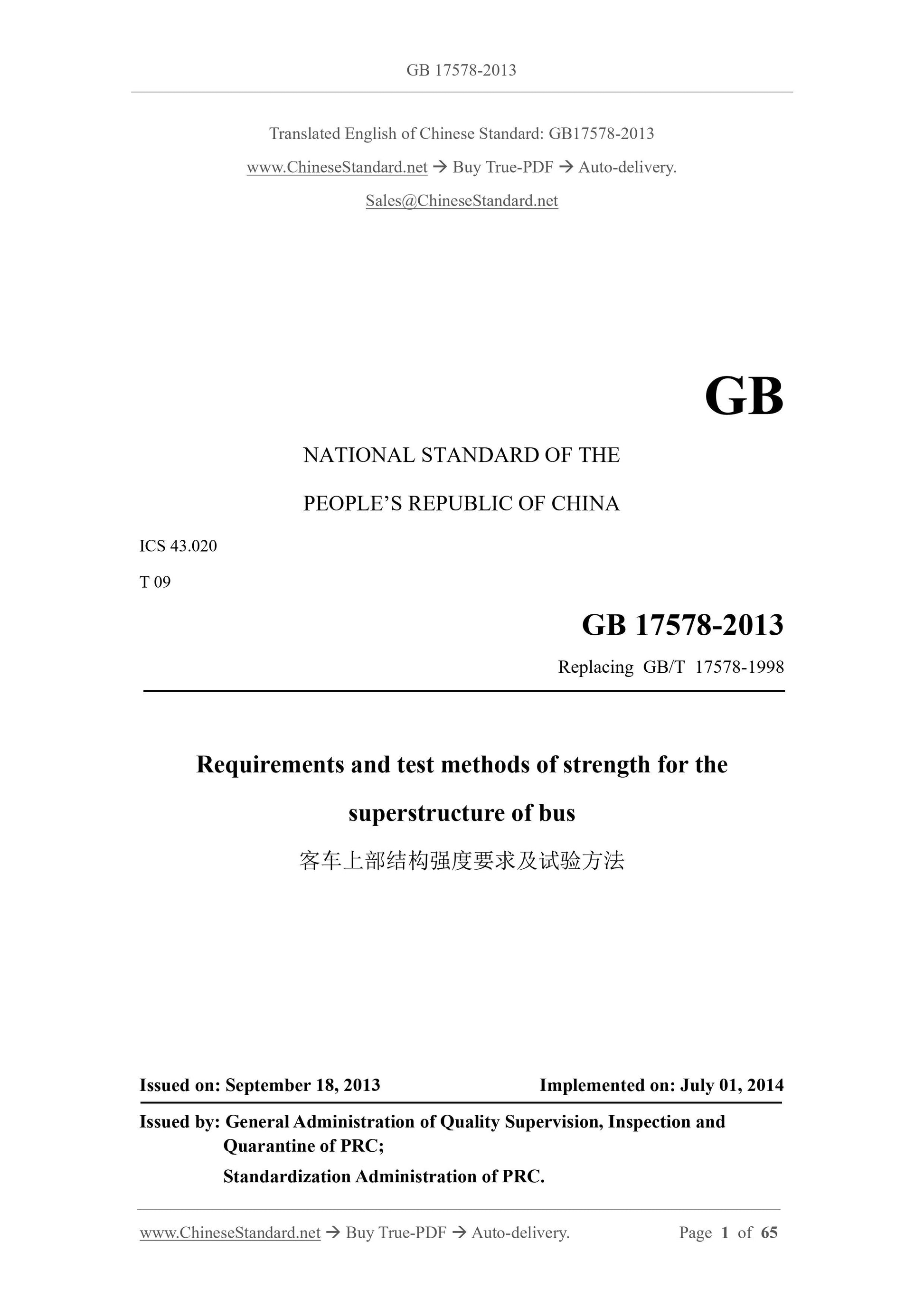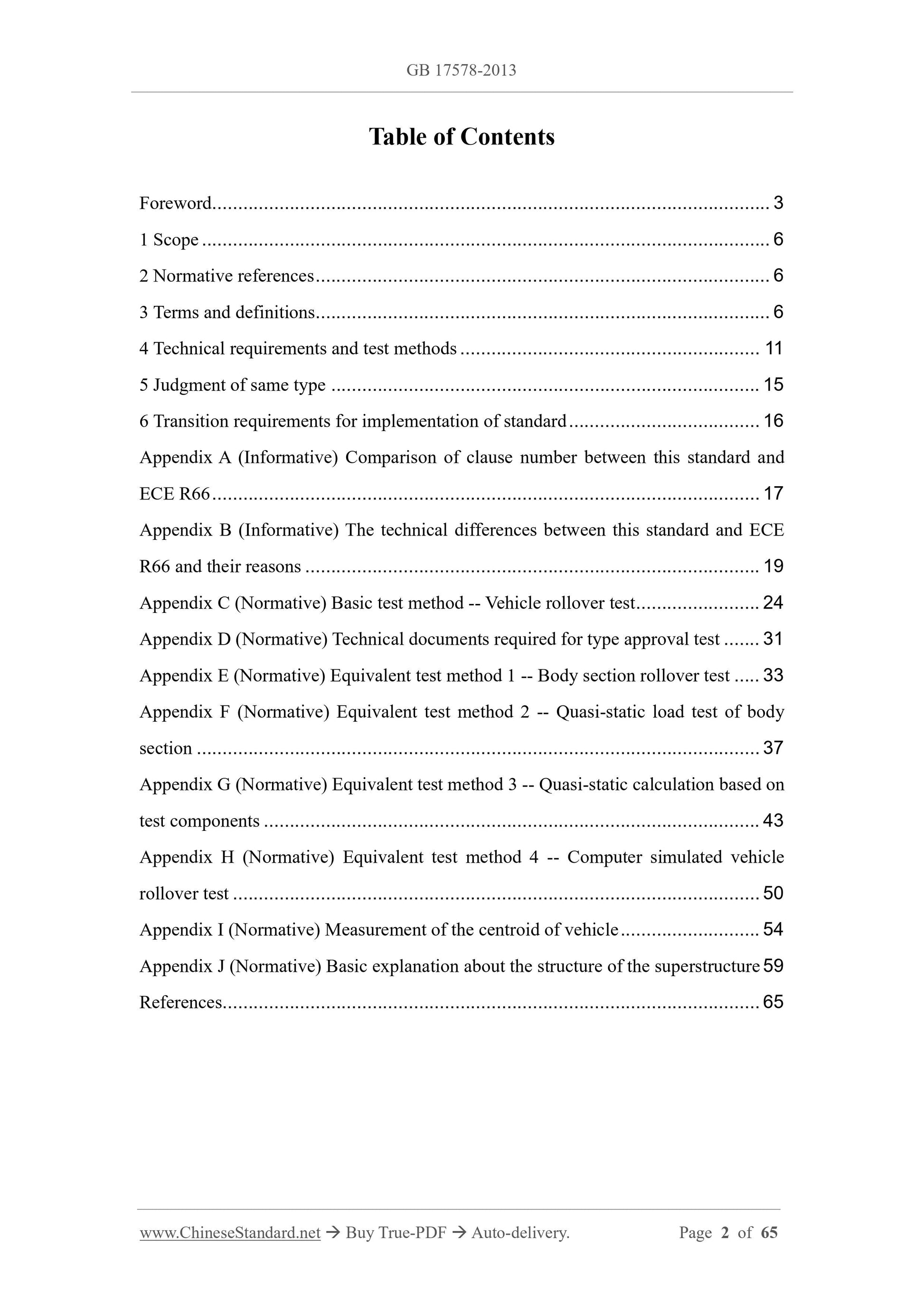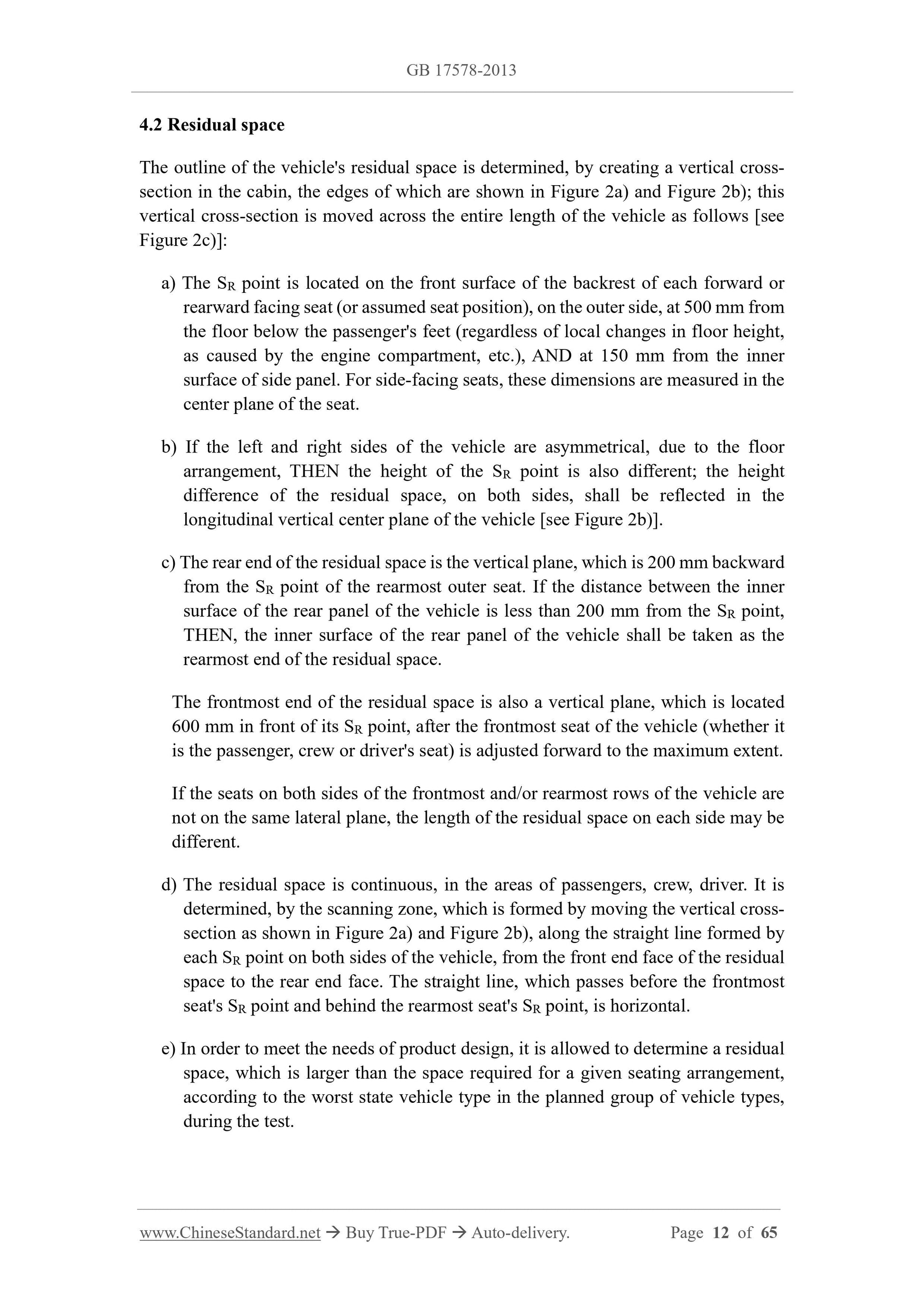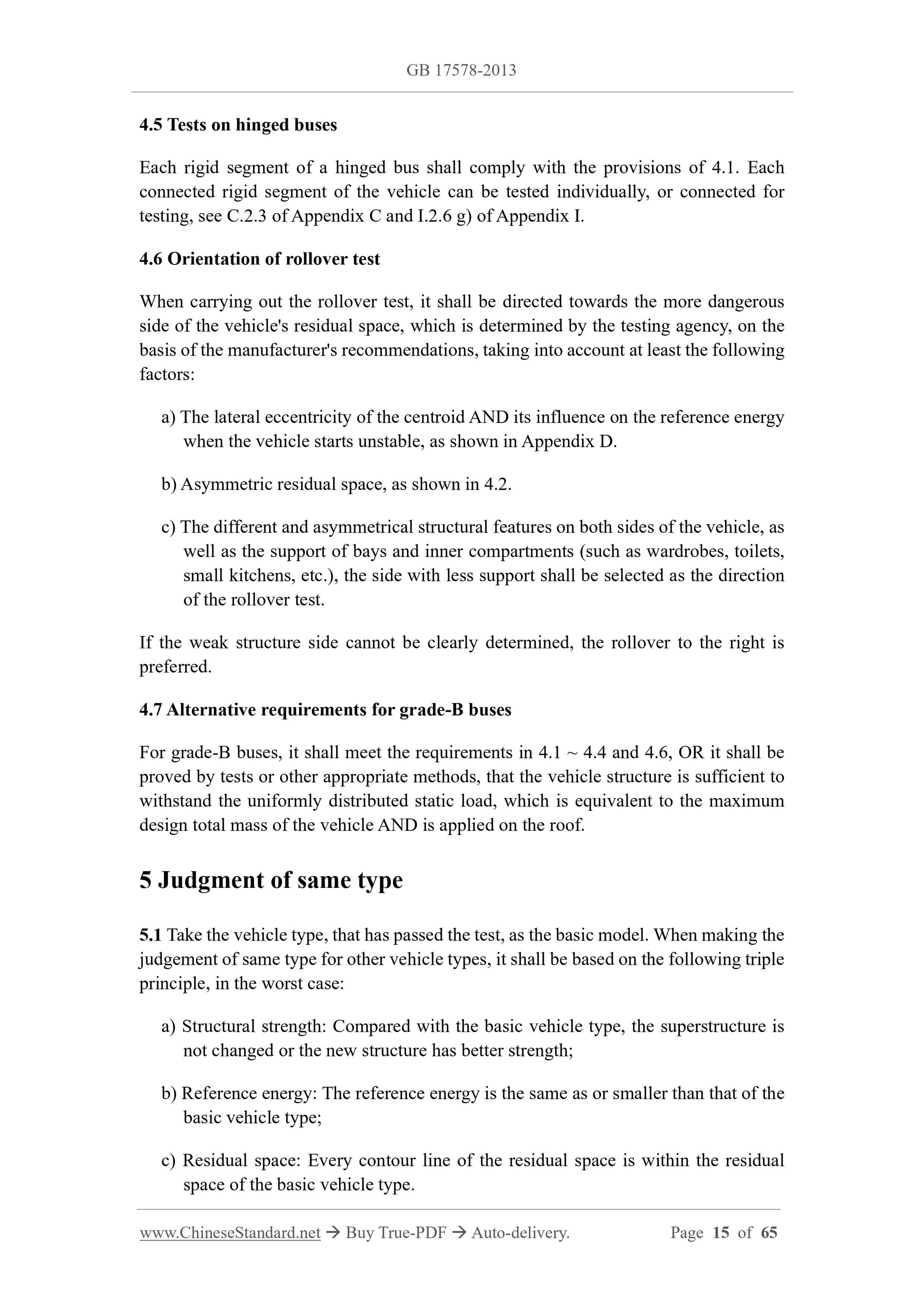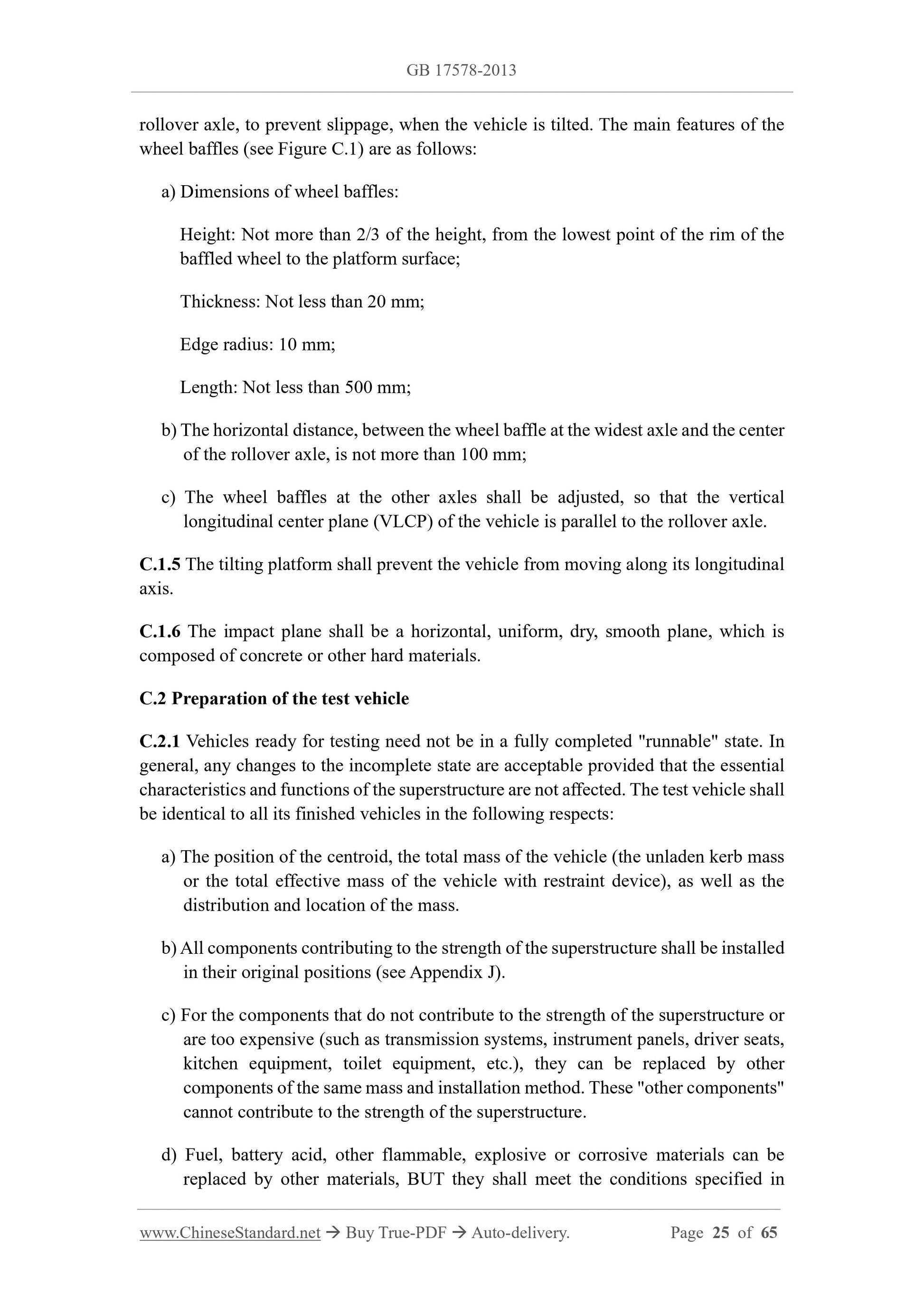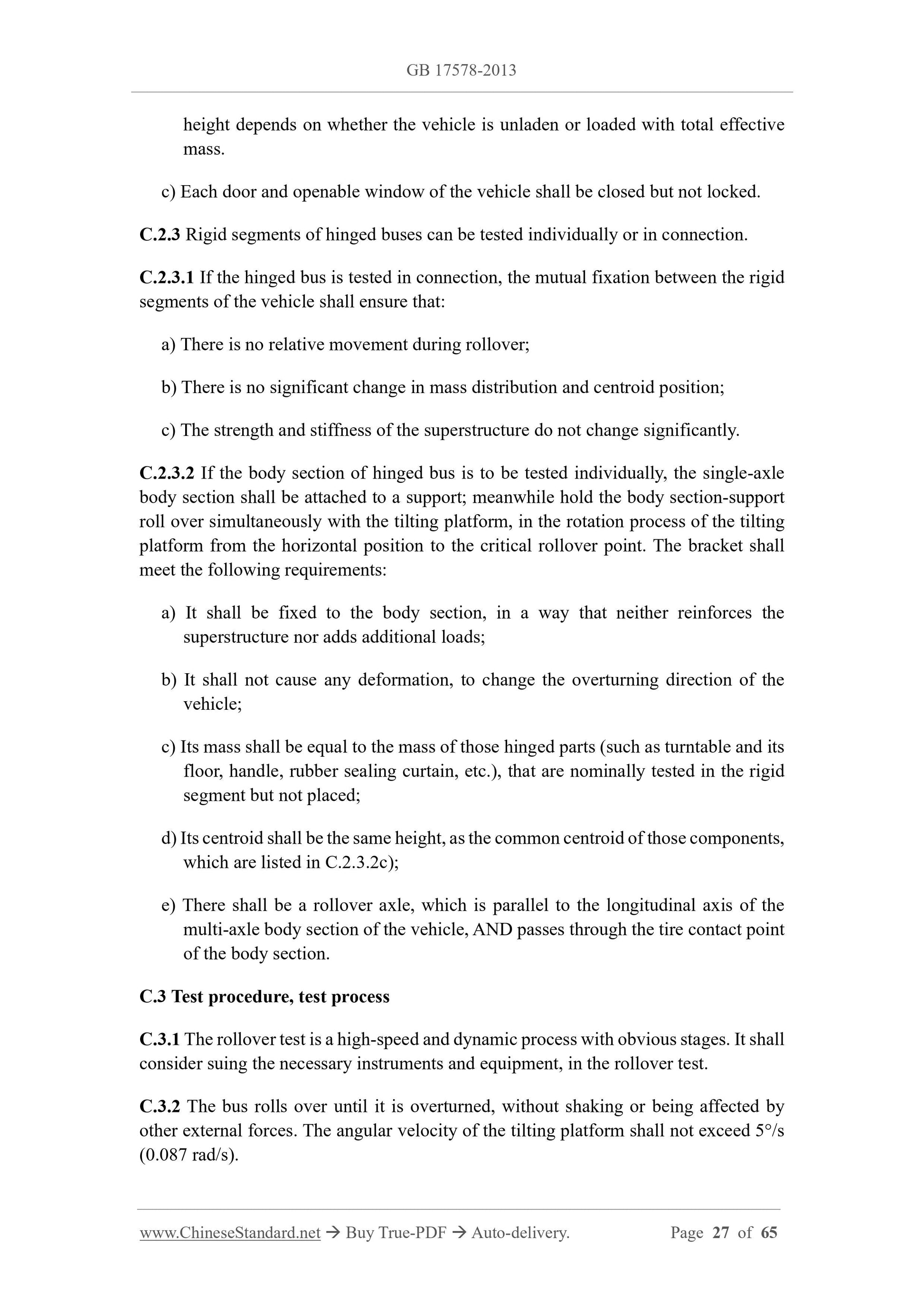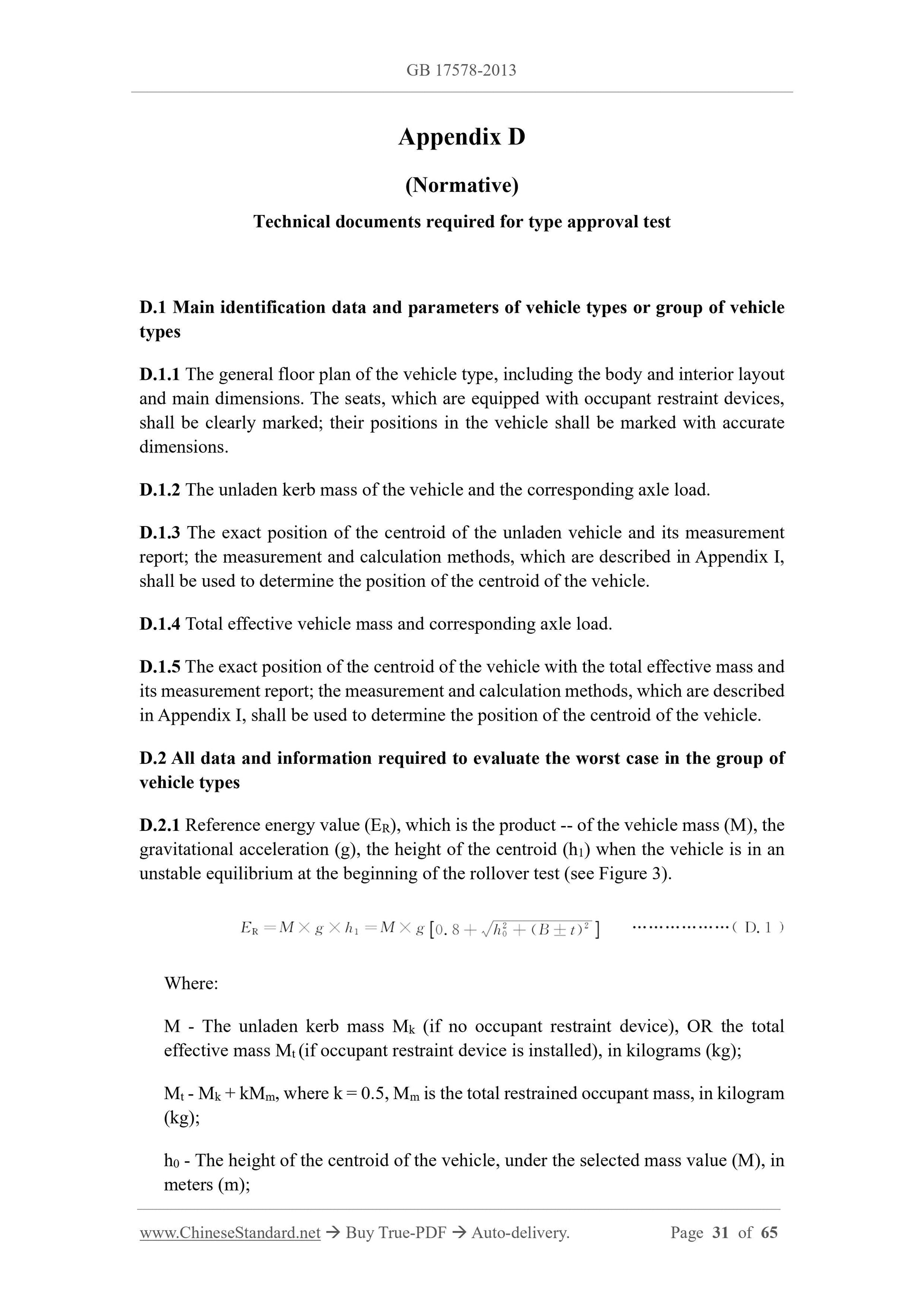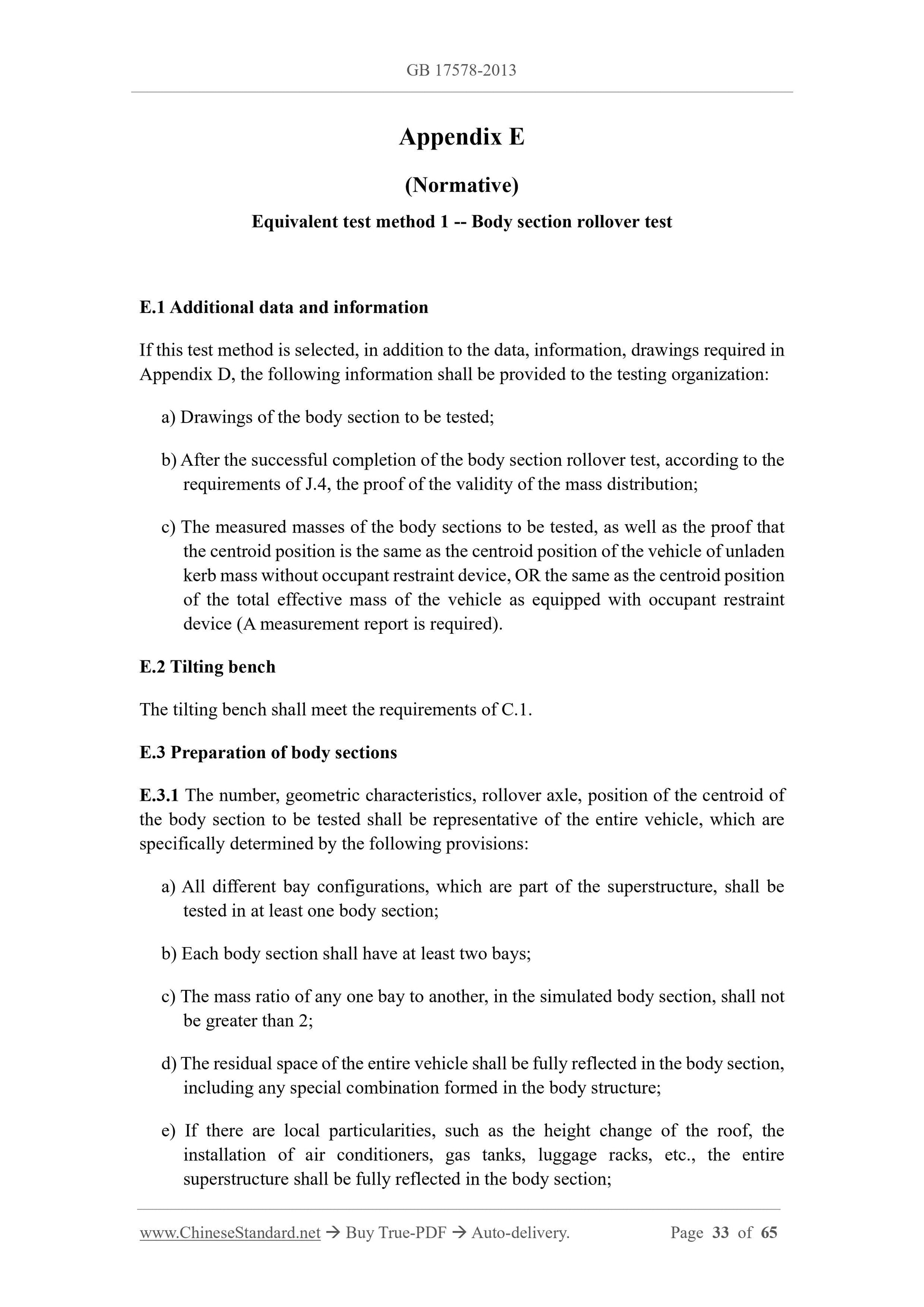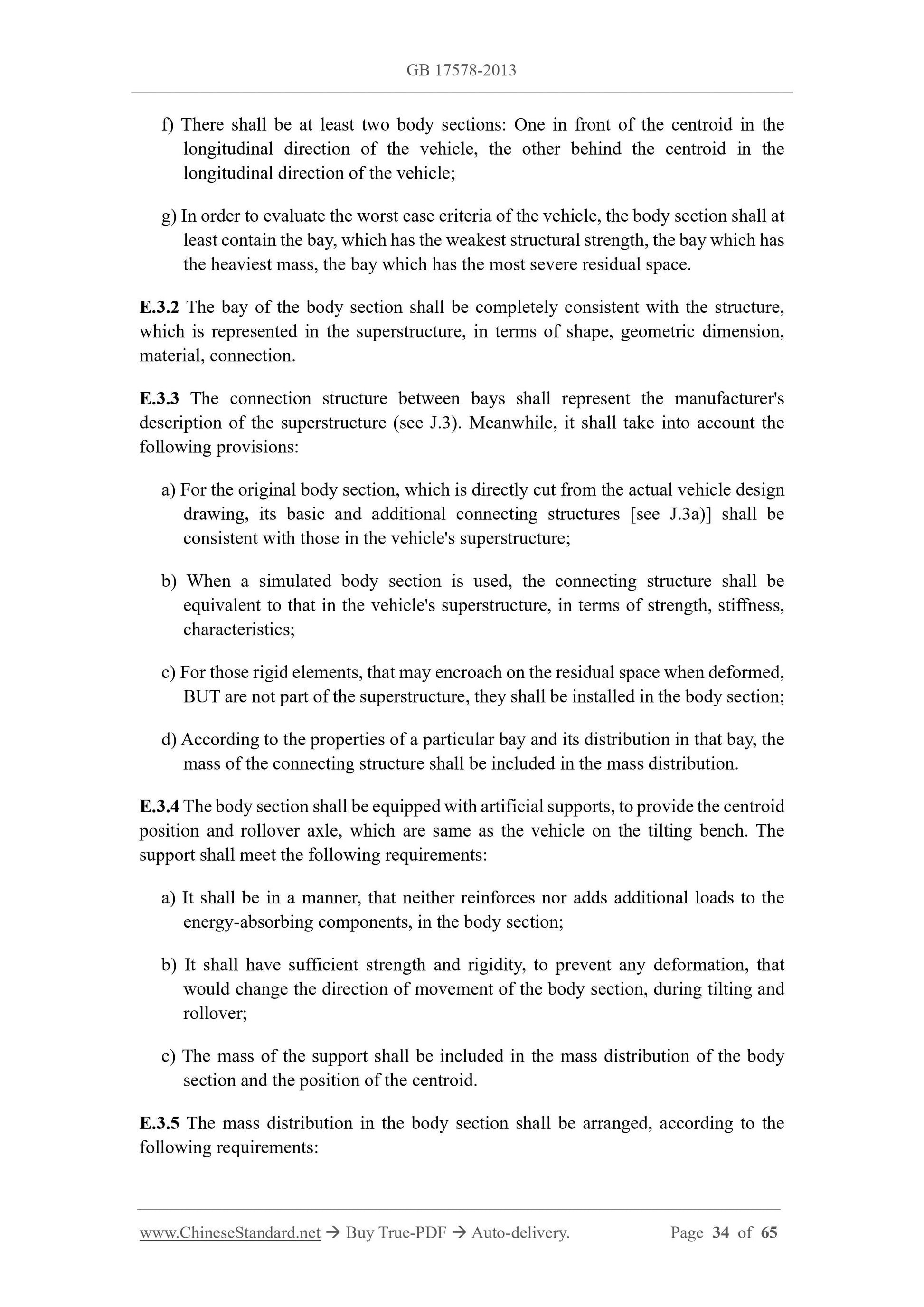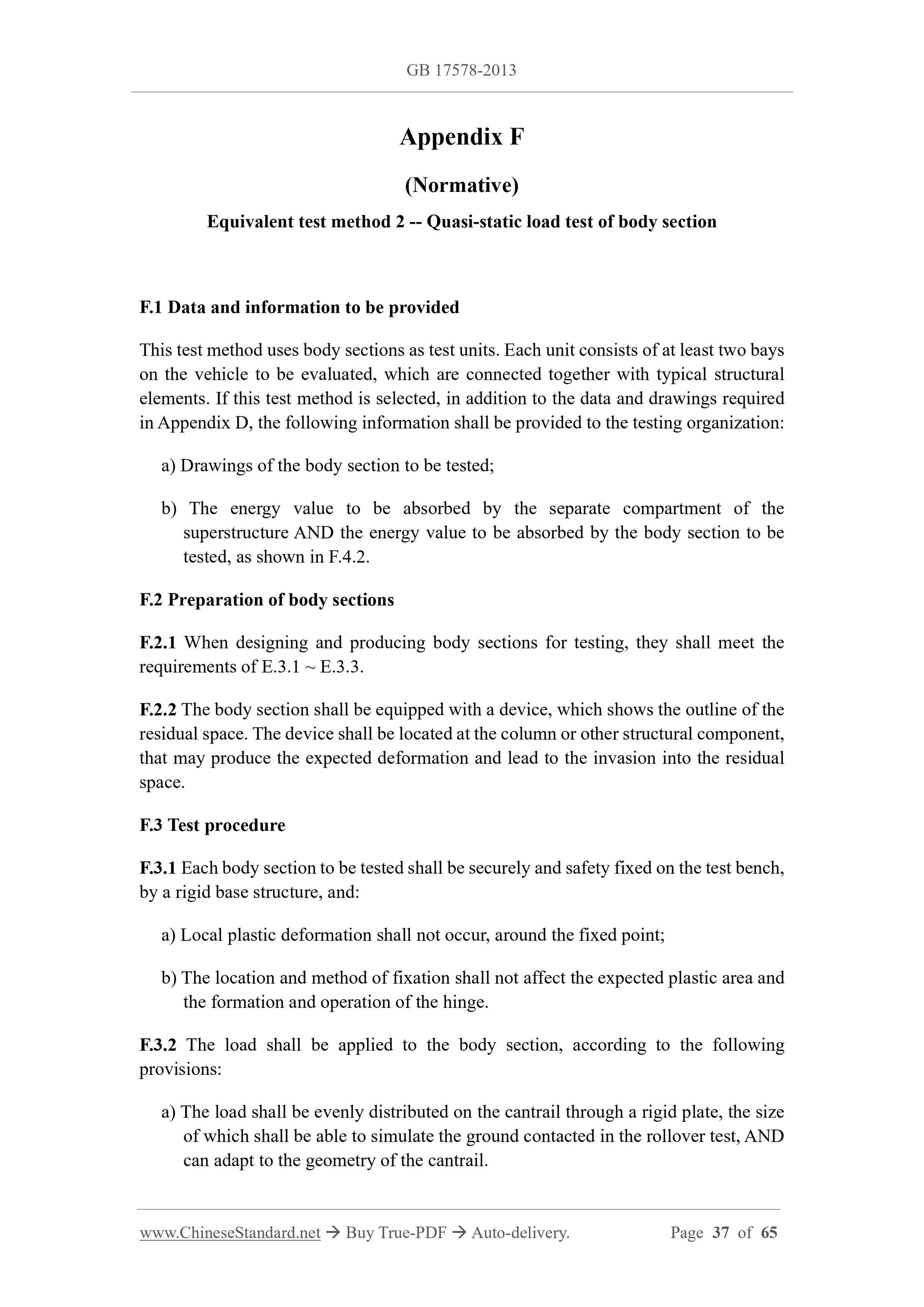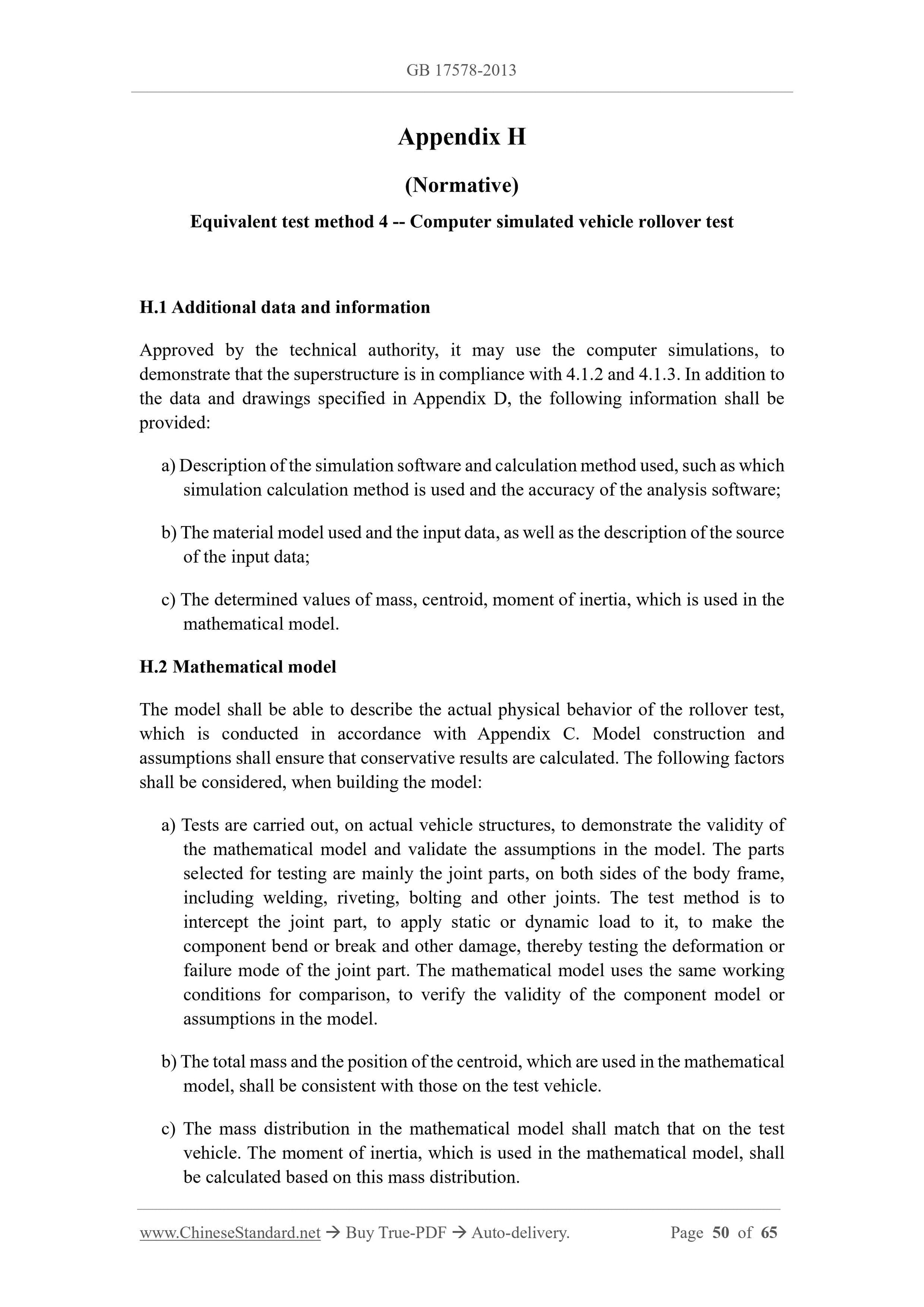PayPal, credit cards. Download editable-PDF & invoice In 1 second!
GB 17578-2013 English PDF (GB17578-2013)
GB 17578-2013 English PDF (GB17578-2013)
Precio habitual
$665.00 USD
Precio habitual
Precio de oferta
$665.00 USD
Precio unitario
/
por
Los gastos de envío se calculan en la pantalla de pago.
No se pudo cargar la disponibilidad de retiro
Delivery: 3 seconds. Download true-PDF + Invoice.
Get QUOTATION in 1-minute: Click GB 17578-2013
Historical versions: GB 17578-2013
Preview True-PDF (Reload/Scroll if blank)
GB 17578-2013: Requirements and test methods of strength for the superstructure of bus
GB 17578-2013
NATIONAL STANDARD OF THE
PEOPLE’S REPUBLIC OF CHINA
ICS 43.020
T 09
Replacing GB/T 17578-1998
Requirements and test methods of strength for the
superstructure of bus
ISSUED ON. SEPTEMBER 18, 2013
IMPLEMENTED ON. JULY 01, 2014
Issued by. General Administration of Quality Supervision, Inspection and
Quarantine of PRC;
Standardization Administration of PRC.
Table of Contents
Foreword... 3
1 Scope... 6
2 Normative references... 6
3 Terms and definitions... 6
4 Technical requirements and test methods... 11
5 Judgment of same type... 15
6 Transition requirements for implementation of standard... 16
Appendix A (Informative) Comparison of clause number between this standard and
ECE R66... 17
Appendix B (Informative) The technical differences between this standard and ECE
R66 and their reasons... 19
Appendix C (Normative) Basic test method -- Vehicle rollover test... 24
Appendix D (Normative) Technical documents required for type approval test... 31
Appendix E (Normative) Equivalent test method 1 -- Body section rollover test... 33
Appendix F (Normative) Equivalent test method 2 -- Quasi-static load test of body
section... 37
Appendix G (Normative) Equivalent test method 3 -- Quasi-static calculation based on
test components... 43
Appendix H (Normative) Equivalent test method 4 -- Computer simulated vehicle
rollover test... 50
Appendix I (Normative) Measurement of the centroid of vehicle... 54
Appendix J (Normative) Basic explanation about the structure of the superstructure 59
References... 65
Requirements and test methods of strength for the
superstructure of bus
1 Scope
This standard specifies the technical requirements and test methods for the strength of
the superstructure of buses.
This standard is applicable to grade B, grade II, grade III buses and special school buses
of categories M2 and M3.Other buses in categories M2 and M3 can be implemented with
reference to this standard.
2 Normative references
The following documents are essential to the application of this document. For the dated
documents, only the versions with the dates indicated are applicable to this document;
for the undated documents, only the latest version (including all the amendments) is
applicable to this standard.
GB 11551 The protection of the occupants in the event of a frontal collision for
motor vehicle
3 Terms and definitions
The following terms and definitions apply to this document.
3.1
Group of vehicle types
A group of current or future vehicle types, that meet or exceed the worst-case test
requirements, according to this standard.
3.2
Worst case
In a group of vehicle types, the vehicle that is least likely to meet the superstructure
strength requirements of this standard. The three parameters to determine the worst
state are structural strength, reference energy, residual space.
4.2 Residual space
The outline of the vehicle's residual space is determined, by creating a vertical cross-
section in the cabin, the edges of which are shown in Figure 2a) and Figure 2b); this
vertical cross-section is moved across the entire length of the vehicle as follows [see
Figure 2c)].
a) The SR point is located on the front surface of the backrest of each forward or
rearward facing seat (or assumed seat position), on the outer side, at 500 mm from
the floor below the passenger's feet (regardless of local changes in floor height,
as caused by the engine compartment, etc.), AND at 150 mm from the inner
surface of side panel. For side-facing seats, these dimensions are measured in the
center plane of the seat.
b) If the left and right sides of the vehicle are asymmetrical, due to the floor
arrangement, THEN the height of the SR point is also different; the height
difference of the residual space, on both sides, shall be reflected in the
longitudinal vertical center plane of the vehicle [see Figure 2b)].
c) The rear end of the residual space is the vertical plane, which is 200 mm backward
from the SR point of the rearmost outer seat. If the distance between the inner
surface of the rear panel of the vehicle is less than 200 mm from the SR point,
THEN, the inner surface of the rear panel of the vehicle shall be taken as the
rearmost end of the residual space.
The frontmost end of the residual space is also a vertical plane, which is located
600 mm in front of its SR point, after the frontmost seat of the vehicle (whether it
is the passenger, crew or driver's seat) is adjusted forward to the maximum extent.
If the seats on both sides of the frontmost and/or rearmost rows of the vehicle are
not on the same lateral plane, the length of the residual space on each side may be
different.
d) The residual space is continuous, in the areas of passengers, crew, driver. It is
determined, by the scanning zone, which is formed by moving the vertical cross-
section as shown in Figure 2a) and Figure 2b), along the straight line formed by
each SR point on both sides of the vehicle, from the front end face of the residual
space to the rear end face. The straight line, which passes before the frontmost
seat's SR point and behind the rearmost seat's SR point, is horizontal.
e) In order to meet the needs of product design, it is allowed to determine a residual
space, which is larger than the space required for a given seating arrangement,
according to the worst state vehicle type in the planned group of vehicle types,
during the test.
4.5 Tests on hinged buses
Each rigid segment of a hinged bus shall comply with the provisions of 4.1.Each
connected rigid segment of the vehicle can be tested individually, or connected for
testing, see C.2.3 of Appendix C and I.2.6 g) of Appendix I.
4.6 Orientation of rollover test
When carrying out the rollover test, it shall be directed towards the more dangerous
side of the vehicle's residual space, which is determined by the testing agency, on the
basis of the manufacturer's recommendations, taking into account at least the following
factors.
a) The lateral eccentricity of the centroid AND its influence on the reference energy
when the vehicle starts unstable, as shown in Appendix D.
b) Asymmetric residual space, as shown in 4.2.
c) The different and asymmetrical structural features on both sides of the vehicle, as
well as the support of bays and inner compartments (such as wardrobes, toilets,
small kitchens, etc.), the side with less support shall be selected as the direction
of the rollover test.
If the weak structure side cannot be clearly determined, the rollover to the right is
preferred.
4.7 Alternative requirements for grade-B buses
For grade-B buses, it shall meet the requirements in 4.1 ~ 4.4 and 4.6, OR it shall be
proved by tests or other appropriate methods, that the vehicle structure is sufficient to
withstand the uniformly distributed static load, which is equivalent to the maximum
design total mass of the vehicle AND is applied on the roof.
5 Judgment of same type
5.1 Take the vehicle type, that has passed the test, as the basic model. When making the
judgement of same type for other vehicle types, it shall be based on the following triple
principle, in the worst case.
a) Structural strength. Compared with the basic vehicle type, the superstructure is
not changed or the new structure has better strength;
b) Reference energy. The reference energy is the same as or smaller than that of the
basic ve...
Get QUOTATION in 1-minute: Click GB 17578-2013
Historical versions: GB 17578-2013
Preview True-PDF (Reload/Scroll if blank)
GB 17578-2013: Requirements and test methods of strength for the superstructure of bus
GB 17578-2013
NATIONAL STANDARD OF THE
PEOPLE’S REPUBLIC OF CHINA
ICS 43.020
T 09
Replacing GB/T 17578-1998
Requirements and test methods of strength for the
superstructure of bus
ISSUED ON. SEPTEMBER 18, 2013
IMPLEMENTED ON. JULY 01, 2014
Issued by. General Administration of Quality Supervision, Inspection and
Quarantine of PRC;
Standardization Administration of PRC.
Table of Contents
Foreword... 3
1 Scope... 6
2 Normative references... 6
3 Terms and definitions... 6
4 Technical requirements and test methods... 11
5 Judgment of same type... 15
6 Transition requirements for implementation of standard... 16
Appendix A (Informative) Comparison of clause number between this standard and
ECE R66... 17
Appendix B (Informative) The technical differences between this standard and ECE
R66 and their reasons... 19
Appendix C (Normative) Basic test method -- Vehicle rollover test... 24
Appendix D (Normative) Technical documents required for type approval test... 31
Appendix E (Normative) Equivalent test method 1 -- Body section rollover test... 33
Appendix F (Normative) Equivalent test method 2 -- Quasi-static load test of body
section... 37
Appendix G (Normative) Equivalent test method 3 -- Quasi-static calculation based on
test components... 43
Appendix H (Normative) Equivalent test method 4 -- Computer simulated vehicle
rollover test... 50
Appendix I (Normative) Measurement of the centroid of vehicle... 54
Appendix J (Normative) Basic explanation about the structure of the superstructure 59
References... 65
Requirements and test methods of strength for the
superstructure of bus
1 Scope
This standard specifies the technical requirements and test methods for the strength of
the superstructure of buses.
This standard is applicable to grade B, grade II, grade III buses and special school buses
of categories M2 and M3.Other buses in categories M2 and M3 can be implemented with
reference to this standard.
2 Normative references
The following documents are essential to the application of this document. For the dated
documents, only the versions with the dates indicated are applicable to this document;
for the undated documents, only the latest version (including all the amendments) is
applicable to this standard.
GB 11551 The protection of the occupants in the event of a frontal collision for
motor vehicle
3 Terms and definitions
The following terms and definitions apply to this document.
3.1
Group of vehicle types
A group of current or future vehicle types, that meet or exceed the worst-case test
requirements, according to this standard.
3.2
Worst case
In a group of vehicle types, the vehicle that is least likely to meet the superstructure
strength requirements of this standard. The three parameters to determine the worst
state are structural strength, reference energy, residual space.
4.2 Residual space
The outline of the vehicle's residual space is determined, by creating a vertical cross-
section in the cabin, the edges of which are shown in Figure 2a) and Figure 2b); this
vertical cross-section is moved across the entire length of the vehicle as follows [see
Figure 2c)].
a) The SR point is located on the front surface of the backrest of each forward or
rearward facing seat (or assumed seat position), on the outer side, at 500 mm from
the floor below the passenger's feet (regardless of local changes in floor height,
as caused by the engine compartment, etc.), AND at 150 mm from the inner
surface of side panel. For side-facing seats, these dimensions are measured in the
center plane of the seat.
b) If the left and right sides of the vehicle are asymmetrical, due to the floor
arrangement, THEN the height of the SR point is also different; the height
difference of the residual space, on both sides, shall be reflected in the
longitudinal vertical center plane of the vehicle [see Figure 2b)].
c) The rear end of the residual space is the vertical plane, which is 200 mm backward
from the SR point of the rearmost outer seat. If the distance between the inner
surface of the rear panel of the vehicle is less than 200 mm from the SR point,
THEN, the inner surface of the rear panel of the vehicle shall be taken as the
rearmost end of the residual space.
The frontmost end of the residual space is also a vertical plane, which is located
600 mm in front of its SR point, after the frontmost seat of the vehicle (whether it
is the passenger, crew or driver's seat) is adjusted forward to the maximum extent.
If the seats on both sides of the frontmost and/or rearmost rows of the vehicle are
not on the same lateral plane, the length of the residual space on each side may be
different.
d) The residual space is continuous, in the areas of passengers, crew, driver. It is
determined, by the scanning zone, which is formed by moving the vertical cross-
section as shown in Figure 2a) and Figure 2b), along the straight line formed by
each SR point on both sides of the vehicle, from the front end face of the residual
space to the rear end face. The straight line, which passes before the frontmost
seat's SR point and behind the rearmost seat's SR point, is horizontal.
e) In order to meet the needs of product design, it is allowed to determine a residual
space, which is larger than the space required for a given seating arrangement,
according to the worst state vehicle type in the planned group of vehicle types,
during the test.
4.5 Tests on hinged buses
Each rigid segment of a hinged bus shall comply with the provisions of 4.1.Each
connected rigid segment of the vehicle can be tested individually, or connected for
testing, see C.2.3 of Appendix C and I.2.6 g) of Appendix I.
4.6 Orientation of rollover test
When carrying out the rollover test, it shall be directed towards the more dangerous
side of the vehicle's residual space, which is determined by the testing agency, on the
basis of the manufacturer's recommendations, taking into account at least the following
factors.
a) The lateral eccentricity of the centroid AND its influence on the reference energy
when the vehicle starts unstable, as shown in Appendix D.
b) Asymmetric residual space, as shown in 4.2.
c) The different and asymmetrical structural features on both sides of the vehicle, as
well as the support of bays and inner compartments (such as wardrobes, toilets,
small kitchens, etc.), the side with less support shall be selected as the direction
of the rollover test.
If the weak structure side cannot be clearly determined, the rollover to the right is
preferred.
4.7 Alternative requirements for grade-B buses
For grade-B buses, it shall meet the requirements in 4.1 ~ 4.4 and 4.6, OR it shall be
proved by tests or other appropriate methods, that the vehicle structure is sufficient to
withstand the uniformly distributed static load, which is equivalent to the maximum
design total mass of the vehicle AND is applied on the roof.
5 Judgment of same type
5.1 Take the vehicle type, that has passed the test, as the basic model. When making the
judgement of same type for other vehicle types, it shall be based on the following triple
principle, in the worst case.
a) Structural strength. Compared with the basic vehicle type, the superstructure is
not changed or the new structure has better strength;
b) Reference energy. The reference energy is the same as or smaller than that of the
basic ve...
Share
